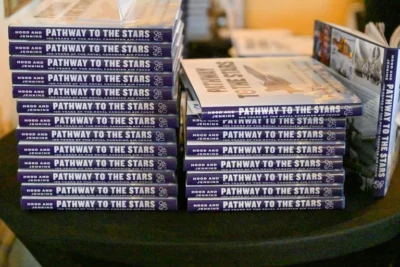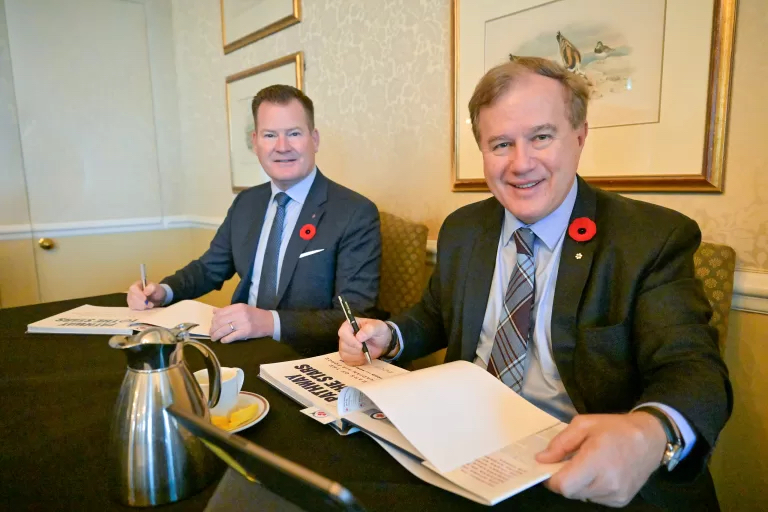A century of Canadian aviation
Pathway to the Stars: 100 Years of the Royal Canadian Air Force
by Michael Hood and Tom Jenkins
Toronto: Aevo UTP, University of Toronto Press, 2023
$39.95 / 9781487547431
Review by Kenneth Favrholdt
*

I thought coffee table-style books were out of fashion but was surprised by this pictorial history: Pathway to the Stars: 100 Years of the Royal Canadian Air Force. On the 100th anniversary of the RCAF, it is a wonderful overview of this part of our military saga by brought together by retired Lieutenant-General Michael Hood (who calls Kelowna home), and RCAF Commanders Advisory Council member Tom Jenkins.
In its more than 248 pages and 240 photographs, this beautifully produced book covering 110 years of the RCAF is full of detail and depth. In eight chapters, the book is “a celebration of the visionary people, marvellous machines, and global events that shaped the RCAF from 1924 to 2024.”
Although the book covers a century of the RCAF, the story actually begins with the birth of aviation in Canada when the Silver Dart took to the air on February 23, 1909, now commemorated as Canada’s National Aviation Day. The flight took place on Bras d’Or Lake in Nova Scotia. The bi-plane was named for the silver, rubberized fabric covering the aircraft built of steel tubing, wood, bamboo, friction tape, and wire.

Two of the first airmen to be profiled are William (Billy) Avery Bishop and William Barker, legends among Canadian aviators. Bishop became famous for the dogfight, meeting the infamous German fighter ace, the “Red Baron,” in one matchup, although neither was victorious. During the Battle of Vimy Ridge in 1917 Bishop shot down 12 planes, was awarded the Military Cross, and later the Victoria Cross and Distinguished Flying Cross.
Bishop called Barker the greatest pilot who ever lived at the time, who shot down 50 enemy planes in the First World War. He was decorated 12 times for bravery, the most decorated Canadian in history and immortalized in Ernest Hemingway’s short fiction story, “The Snows of Kilimanjaro.” Although described as a “bloody murderous bastard” in the tale, in real life he was admired by his men.
Bishop and Barker met and formed a business partnership after the war, Bishop-Barker Aeroplanes, until 1922. Barker later became the first president of the Toronto Maple Leafs hockey team.
The RCAF was formally created by royal decree in 1924 with the appellation “Royal” added by King George V in April of that year. Also, that year, the RCAF became the platform for the aerial photography of the country.
Chapter Two focuses on the RCAF’s role during the Second World War. Various aircraft are profiled such as the Spitfire, Handley Page Halifax Bomber, and the Avro Lancaster which became the most famous Allied bomber of World War II. The G-suit, allowing pilots to experience greater acceleration in a dive, was first tested with the Spitfire, “the fastest military aircraft in the world at the time, with a maximum speed of 550 km/h.”
The Hawker Hurricane was the first fighter plane designed by a woman, Elizabeth ‘Elsie’ MacGill, a 35-year-old aeronautical engineer in charge of its mass production.
In 1944, the RCAF reached its peak as the 4th largest Allied Air Force with over 215,000 personnel. A few famed fliers of many who are profiled include Elizabeth “Elsie” MacGill, Allan Bundy, James Stocky Edwards, and George Buzz Beurling.

Allan Bundy broke the colour barrier in the RCAF when Black Canadians weren’t permitted to take on the roles of pilots or even aircrew until 1942. James Edwards in his illustrious career flew 373 combat missions and shot down 20 enemy aircraft, and in 2009 was named one of the 100 “most influential Canadians in aviation.” George Beurling has been called “the most successful flying ace in the Second World War,” downing 28 Axis aircraft in just 14 days over Malta in the Mediterranean in 1942 which earned him the nickname, “the Falcon of Malta.”
Chapter Three covers the Cold War Years, 1946-1991, when the RCAF expanded from 12,000 postwar personnel and five squadrons, to 50,000 personnel and 41 squadrons. Twelve squadrons were relocated to Europe using a route known as “Operation Leap Frog” from Goose Bay or Gander to Greenland, Iceland and on to Scotland, England, France and Germany, all flying supersonic F-86 Sabres.
The Korean War saw the first RCAF combatant, Flight Lieutenant Omer Lévesque fly to Korea with the USAF, accompanied by flight nurse Joan Fitzgerald.
The Avro Arrow CF-105 is a well-known, popular story of a jet – a twin-engine long-range, all weather supersonic interceptor — ahead of its time that succumbed to political decisions when production was ended in 1959.
What will come as a surprise to many readers described in Chapter Four is the dissolution of the RCAF in the 1960s by the Minister of Defense, Paul Hellyer. General Paul David Manson states: “In celebration of the 100th anniversary of the Royal Canadian Air Force, I wonder how many Canadians realize that the RCAF didn’t exist for 48 of those years.”
The RCAF, along with the flight organizations of the army and navy, became collectively known as the ‘Air Element.’ …. Along with its name and uniform, much of the RCAF’s rich heritage was lost under unification.
Despite its fragmented identity, the RCAF continued to expand its capabilities in the areas of transport, medical evacuation, and Search and Rescue (SAR). The heavy duty transport aircraft, the CC-130 Hercules, joined the ranks of Canada’s Air Force…able to carry just about anything… delivering much needed aid and rescue during humanitarian crises and natural disasters.
The RCAF, however, was resurrected in 1975 and returned to its “Blue” uniform.
Chapter Five deals with Expeditionary Operations such as the First Gulf War, the Airbridge to Rwanda, the Kosovo Campaign in 1999, the response on 9/11, Afghanistan, fighting ISIS in Iraq and Syria, and other missions, including protecting NATO’s Eastern Flank.
Chapter Six deals with Search and Rescue (SAR) and Humanitarian Operations which took shape during the Second World War. There is a profile of Captain Wilfrid Red “Wop” May, known as the Father of Canadian Pararescue, and the Parabelles, the first women officers to wear the badge of qualified RCAF rescue personnel. Corporal Tammy Negraeff spent seven years training to complete an airborne jumping course.
Chapter Seven announces that “the RCAF is back” when on August 16, 2011 the Government of Canada reverted from “Air Command” to the original historic name and a new badge with the motto Sic Itur Ad Asta, “Such is the pathway to the stars.”
There is a profile of astronaut Chris Hadfield who became a fighter pilot with the RCAF and subsequently earned his wings and graduated with honors from 2 Canadian Forces Flying School at CFB Moose Jaw. Bringing the space exploits up-to date, Canadian Space Agency astronaut Jeremy Hansen will fly aboard Artemis II with NASA astronauts to the moon.
Back to earth, there is a profile of the RCAF Aerobatic Teams – the Sky Lancers and the Snowbirds, 50 years strong, NORAD including their Santa Claus mission, and the RCAF Band which began in the 1940s.
The eighth and final chapter reflects on the impact of the RCAF followed by profiles of memorials specific to the RCAF, including the Canadian National Vimy Memorial, the Arras Flying Services Memorial, the National War Memorial, the Juno Beach Centre, RAF Bomber Command Memorial, the Ottawa Memorial, the Dieppe Gardens, the RCAF Memorial at 16 Wing Borden, and the Malta Memorial. Of special interest is Les Sutherland, serving with the 426 Thunderbird Squadron in World War Two but shot down in Haaksbergen, Netherlands, and honoured with plaques in Corunna, Ontario, and on the Bomber Command Memorial Wall in Nanton, Alberta.
The book concludes with several Appendices including a list of RCAF Commanders from 1914 to the present, profiles of RCAF Victoria Cross recipients, a list of Current and Historical Aircraft, RCAF Organizations and Ceremonies, and a Timeline of the RCAF from 1909 to the present year.
There is an extensive bibliography followed by a list of photo credits, and an excellent index. The book is beautifully illustrated with stunning photographs of the aircraft. Even the book’s inside cover is utilized – a map showing the location of RCAF bases across the country. A nod should go out to the publisher, Aevo UTP, an imprint of the University of Toronto Press, for this exceptional production.
“Pathway to the Stars” is a must for anyone interested in the story of Canadian aviation and the proud military accomplishments of the RCAF.

*

Kenneth Favrholdt is a freelance writer, historical geographer and museologist with a BA and MA (Geography, UBC), a teaching certificate (SFU), and certificates as a museum curator. He spent ten years at the Kamloops Museum & Archives, five at the Secwépemc Museum and Heritage Park, four at the Osoyoos Museum, and he is now Archivist of Tk’emlúps te Secwépemc. He has written extensively on local history in Kamloops This Week, the former Kamloops Daily News, the Claresholm Local Press, and other community papers. Ken has also written book reviews for BC Studies and articles for BC History, Canadian Cowboy Country Magazine, Cartographica, Cartouche, and MUSE (magazine of the Canadian Museums Association). He taught geography courses at Thompson Rivers University and edited the Canadian Encyclopedia, geography textbooks, and a commemorative history for the Town of Oliver and Osoyoos Indian Band. Ken has undertaken research for several Interior First Nations and is now working on books on the fur trade of Kamloops and the gold rush journal of John Clapperton, a Nicola Valley pioneer and Caribooite. He lives in Kamloops. [Editor’s note: Kenneth Favrholdt has recently reviewed books by Rueben George with Michael Simpson, Jo Chrona, Marc G. Stevenson, George H. S. Duddy, Terrance N. James, and Mali Bain for The British Columbia Review.]
*
The British Columbia Review
Interim Editors, 2023-25: Trevor Marc Hughes (non-fiction), Brett Josef Grubisic (fiction)
Publisher: Richard Mackie
Formerly The Ormsby Review, The British Columbia Review is an online book review and journal service for BC writers and readers. The Advisory Board now consists of Jean Barman, Wade Davis, Robin Fisher, Barry Gough, Hugh Johnston, Kathy Mezei, Patricia Roy, Maria Tippett, and Graeme Wynn. Provincial Government Patron (since September 2018): Creative BC. Honorary Patron: Yosef Wosk. Scholarly Patron: SFU Graduate Liberal Studies. The British Columbia Review was founded in 2016 by Richard Mackie and Alan Twigg.
“Only connect.” – E.M. Forster
2 comments on “A century of Canadian aviation”